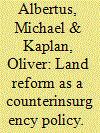| Srl | Item |
| 1 |
ID:
157509


|
|
|
|
|
| Summary/Abstract |
What determines the recidivism of ex-combatants from armed conflicts? In postconflict settings around the world, there has been growing interest in reintegration programs to prevent ex-combatants from returning to illegal activities or to armed groups, yet little is known about who decides to “go bad.” We evaluate explanations for recidivism related to combatant experiences and common criminal motives by combining data from a representative survey of ex-combatants of various armed groups in Colombia with police records of observed behaviors that indicate which among the respondents returned to belligerent or illegal activities. Consistent with a theory of recidivism being shaped by driving and restraining factors, the results suggest that factors such as antisocial personality traits, weak family ties, lack of educational attainment, and the presence of criminal groups are most highly correlated with various kinds of recidivism and hold implications for programs and policies to successfully reintegrate ex-combatants into society.
|
|
|
|
|
|
|
|
|
|
|
|
|
|
|
|
| 2 |
ID:
120123


|
|
|
|
|
| Publication |
2013.
|
| Summary/Abstract |
Can targeted land reform reduce levels of civil war conflict by mitigating the factors that contribute to rural rebellion? This article uses new micro-level data on land reform and insurgency at the municipal level from Colombia from 1988 to 2000, a country with high rates of land inequality and informal land ownership, to test whether land reform undercut subsequent guerrilla activity. The reform had two distinct aspects. Politically powerful large landholders blocked most large-scale reform, which resulted primarily in an enduring, low-intensity, and geographically dispersed reform that spurred low levels of insurgent activity. Larger-scale reforms were only implemented in areas that threatened serious violence and had the potential to harm elite interests, and in these limited areas reform reduced guerrilla activity. This suggests that while land reform can be an effective counterinsurgency policy, it may be politically difficult to implement at a sufficient scale because it threatens the status quo.
|
|
|
|
|
|
|
|
|
|
|
|
|
|
|
|
| 3 |
ID:
120771


|
|
|
|
|
| Publication |
2013.
|
| Summary/Abstract |
Can local organizations give civilians the capacity to protect themselves from civil war violence? Civilians have traditionally been considered powerless when facing armed groups but new research suggests organized communities may promote security through nonviolent strategies such as resolving disputes between neighbors and managing relations with macro-armed actors. This article analyzes whether and how these 'mechanisms' designed to retain community autonomy functioned in the community-case of the Peasant Worker Association of the Carare River (ATCC) in Colombia. The Carare civilians developed a local institutional process to investigate threats against suspected armed group collaborators to clarify the 'fog of war' and reform civilian preferences to participate in the conflict. This process is evaluated in reference to existing hypotheses about violence in civil wars such as the balance of territorial control using qualitative evidence from original field research. A unique within-case database created through focus group sessions with community 'conciliators' is used to analyze not only acts of violence, but also threats that were defused. Despite the prevalence of conditions that would predict persistent violence against civilians, the local institution itself proved to be a critical factor for both explaining and limiting levels of violence. The results suggest civilian choices and their consequences did not merely result from the capabilities or choices of armed actors.
|
|
|
|
|
|
|
|
|
|
|
|
|
|
|
|